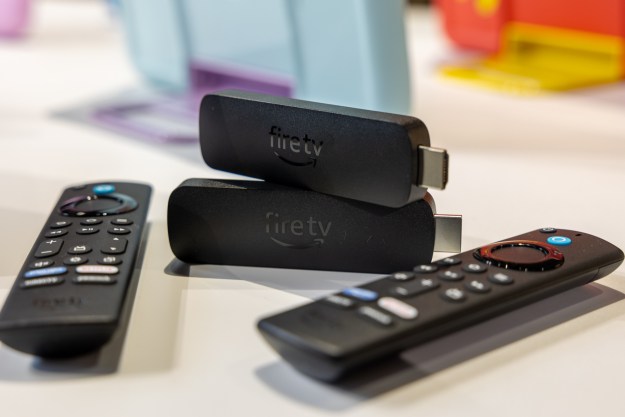Stick vs. Dongle
Let’s first take a look at the devices themselves. We call the Amazon Fire TV a dongle because, well, it dangles. This has some advantages as it will be easy to plug in to most televisions, but a potential drawback to this design is that it can put stress on some HDMI ports due to its weight. We suggest using double-sided tape or Velcro to affix the device to the back of the TV, just to be on the smart side.
The Roku Streaming Stick+ is a more compact, light-weight stick, with its 801.11AC dual-band antenna built into the power cable, which you can’t replace. The idea behind this design is that Roku’s external antenna could end up pulling in a stronger Wi-Fi signal in tough reception spots like hotels and dorms where you may be far away from a Wi-Fi router.
Unfortunately, because of its 3.75-inch length, the
Your magic wand
Perhaps the most impactful differences between these devices are in their on-screen interfaces.
Taking a look at the remote controls, there are some obvious differences. Both remotes have voice control buttons – we’ll get to that later – and both have cursor controls, but the
The user experience
Perhaps the most impactful differences between these devices are in their on-screen interfaces. The Fire TV interface is a polished product. It feels modern and sleek, partly because the graphics are beautiful to look at. You’ll notice in our video, though, that what you see most prominently is stuff Amazon wants you to watch through its streaming service. You have to do a bit of extra clicking to get to Netflix and other apps, but they are there, and the quality of those apps is strong. You do get the latest version of apps with Fire TV these days, which is a step up from when the device debuted a couple of years ago. The Fire TV also includes a couple of web browsers, Mozilla Firefox and Amazon Silk. While Amazon and Mozilla claim both offer the full web experience, the same as you would find on desktop or mobile, we have yet to test them — and TV web browsers have a history of inconsistency. We’ll be sure to update once we’ve had time with them.
On the
To Alexa or not to Alexa: Some searches are smarter than others
Outside of Apps, the Fire TV offers mobile-style games, and there are some pretty good ones, worth playing if you get the dedicated gaming controller, sold separately. But the Fire TV’s real ace in the hole is Alexa. And not just built-in Alexa — any Alexa-enabled device in your house can control the Fire TV, like an Amazon Echo or Sonos One. Or, at least,
You can pull up the Fire TV remote and ask
In our demonstration, we call up Orange is the New Black, and where the Fire TV OS used to pull up Amazon’s offerings to rent or buy first, we now see that Amazon shows the title as being available on Netflix. On the downside, you must navigate to a “more ways to watch” icon to see where else the show is available, and Amazon will be the only result you see.
Contrast that with the
We then search for a movie we know is available free on Netflix, and paid elsewhere. “Show me Sausage Party” on
Contrast that with Fire TV which, again, does show Netflix as a free option, but does not offer any other suggestions on where to watch outside of Amazon.
Picture and sound
In terms of video and audio quality, the two are evenly matched. Both support 4K HDR content with HDR10, neither support Dolby Vision HDR, and both support Dolby Atmos audio for the best streaming surround sound.
The takeaway
We think the
Bottom line: Both the Amazon Fire TV and
The Amazon Fire TV has its place, though, and this author loves using it, too. For
Update: Added information on the web browsers currently available for both Fire TV and
Editors' Recommendations
- Let’s discuss an Apple TV 4K with a camera
- Best streaming devices for 2024: Apple TV, Roku, Fire TV, and more
- There’s only one streaming device that lets you escape ads
- You can now make your own AI art with Amazon Fire TV
- Panasonic’s latest OLED TVs are the first with Amazon Fire TV built-in








